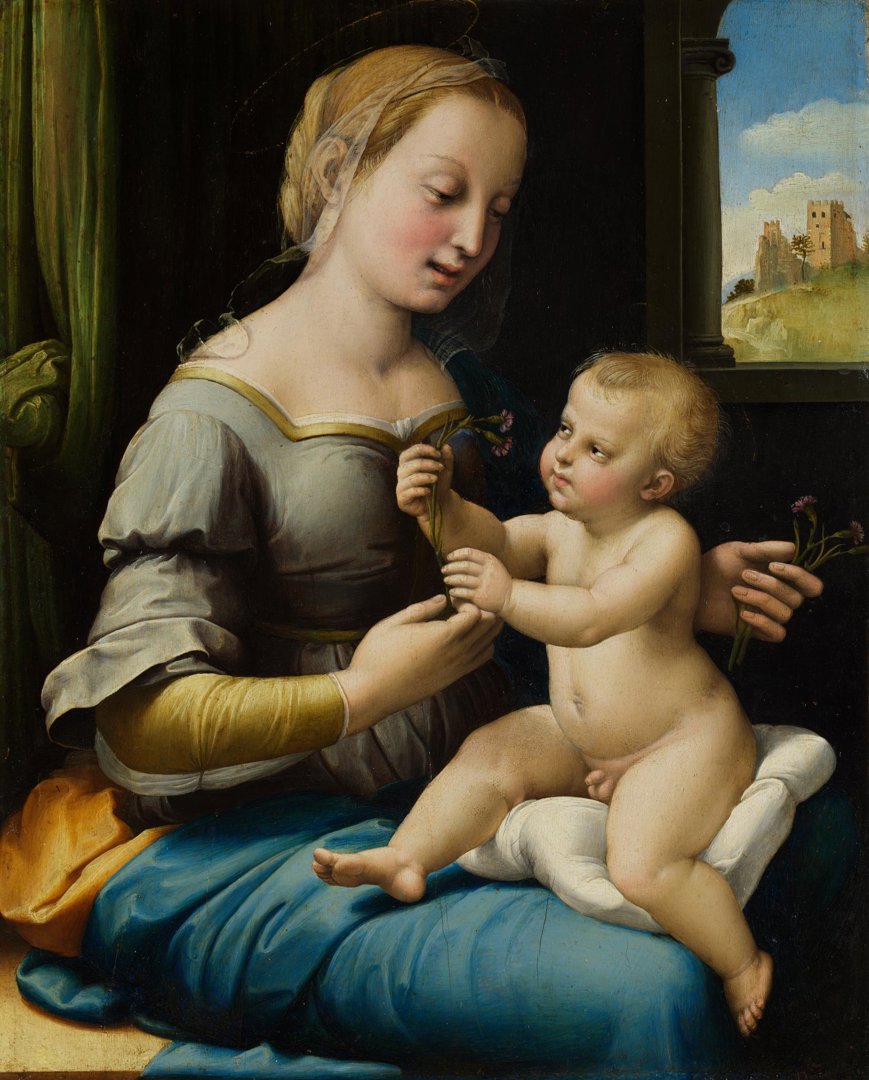Raphael's 'The Madonna of the Pinks'
Audio description
This is a description of 'The Madonna of the Pinks' ('La Madonna dei Garofani') by Raphael. It is oil on yew, painted between 1506 and 1507. It is relatively small, measuring just under 28 cm high and about 22 cm wide, which suggests that it may have been made to be held in the hand, for intimate prayer. It sits within a thick, gold frame, plainly decorated with textured bands.
The painting depicts an interior scene of a mother and child. The two serene figures take up most of the painting. The mother figure, or, the Madonna of the Pinks, is seated, her body angled towards the right. Her attention is given fully over to her child, head tilted down, as she gazes lovingly at the infant Christ on her lap.
She wears a grey silk dress, the bodice exposing her neck and shoulders. It has elbow length sleeves over the longer wrist-length sleeves of a gold silk underdress. Her dark blond hair is tied back, a translucent veil draped over her head and falling to her shoulder. The thinnest, barely perceptible, golden halo hovers over her head, alluding to her identity as the Virgin Mary.
On the left-hand side of the painting, hangs a green curtain, knotted to hold it back. It contains different hues: lime green, khaki, and emerald. The inclusion of the curtain hints that this is a personal space, perhaps the Madonna’s bedchamber.
An arched window in the top right, is partly cut off by the edge of the painting. It draws our focus to the landscape outside, perhaps an allusion to the bridge between the heavenly and the earthly. This outside scene is made up of blue sky, with white clouds above a green hill and a castle. It has a crenelated tower on the right, and an impression of a ruin on the left. In painting this window, Raphael has gone to the trouble of including the damage to the windowsill, where there is a small chip on the stone . This is depicted by a dab of white paint, placed at the very edge of the painting.
In spite of the daylight through the window, the light that encloses the mother and child does not seem to be coming from there, coming instead from the left.
The infant Jesus sits on a soft, white cushion on his mother’s knees, which are draped with blue silk. Completely naked, he is turned towards her, cherub-like, with plump legs and cheeks, dimpled arms, and light blond hair. One leg rests across her thigh, the other dangles down, foot pointing towards the bottom right-hand corner of the canvas. He is lifting his arms towards his mother, his gaze on two flowers in his
hands. He is either taking these from his mother or giving them to her, as she tenderly holds her right hand beneath his. Her left arm is supporting him from behind, and in that hand, she holds two more of the same flowers.
These flowers have been identified as carnations, also known as ‘pinks’, giving the painting its title. This flower was a traditional symbol of divine love and was said to have grown from the earth where the Virgin’s tears fell during Christ’s Passion.


